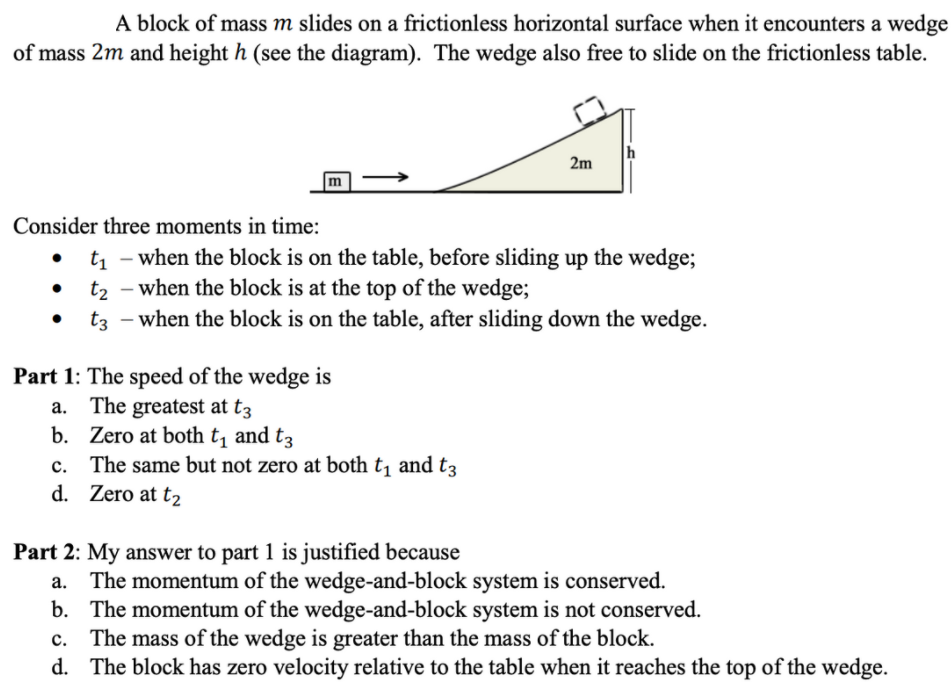A block of mass m slides on a frictionless horizontal surface when it encounters a wedge of mass 2m and height h (see the diagram). The wedge also free to slide on the frictionless table. 2m m Consider three moments in time: t - when the block is on the table, before sliding up the wedge; t2 - when the block is at the top of the wedge; t3 - when the block is on the table, after sliding down the wedge. Part 1: The speed of the wedge is a. The greatest at t3 b. Zero at both t, and t3 c. The same but not zero at both t, and t3 d. Zero at t2 Part 2: My answer to part 1 is justified because a. The momentum of the wedge-and-block system is conserved. b. The momentum of the wedge-and-block system is not conserved. c. The mass of the wedge is greater than the mass of the block. d. The block has zero velocity relative to the table when it reaches the top of the wedge.
A block of mass m slides on a frictionless horizontal surface when it encounters a wedge of mass 2m and height h (see the diagram). The wedge also free to slide on the frictionless table. 2m m Consider three moments in time: t - when the block is on the table, before sliding up the wedge; t2 - when the block is at the top of the wedge; t3 - when the block is on the table, after sliding down the wedge. Part 1: The speed of the wedge is a. The greatest at t3 b. Zero at both t, and t3 c. The same but not zero at both t, and t3 d. Zero at t2 Part 2: My answer to part 1 is justified because a. The momentum of the wedge-and-block system is conserved. b. The momentum of the wedge-and-block system is not conserved. c. The mass of the wedge is greater than the mass of the block. d. The block has zero velocity relative to the table when it reaches the top of the wedge.
Related questions
Question

Transcribed Image Text:A block of mass m slides on a frictionless horizontal surface when it encounters a wedge
of mass 2m and height h (see the diagram). The wedge also free to slide on the frictionless table.
2m
m
Consider three moments in time:
t - when the block is on the table, before sliding up the wedge;
t2 - when the block is at the top of the wedge;
t3 - when the block is on the table, after sliding down the wedge.
Part 1: The speed of the wedge is
a. The greatest at t3
b. Zero at both t, and t3
c. The same but not zero at both t, and t3
d. Zero at t2
Part 2: My answer to part 1 is justified because
a. The momentum of the wedge-and-block system is conserved.
b. The momentum of the wedge-and-block system is not conserved.
c. The mass of the wedge is greater than the mass of the block.
d. The block has zero velocity relative to the table when it reaches the top of the wedge.
Expert Solution
This question has been solved!
Explore an expertly crafted, step-by-step solution for a thorough understanding of key concepts.
This is a popular solution!
Trending now
This is a popular solution!
Step by step
Solved in 2 steps
